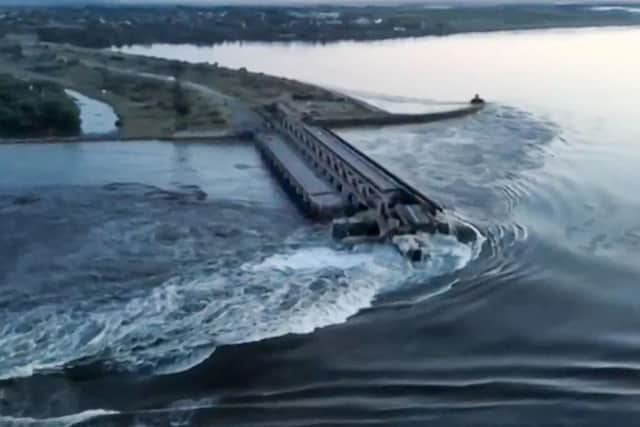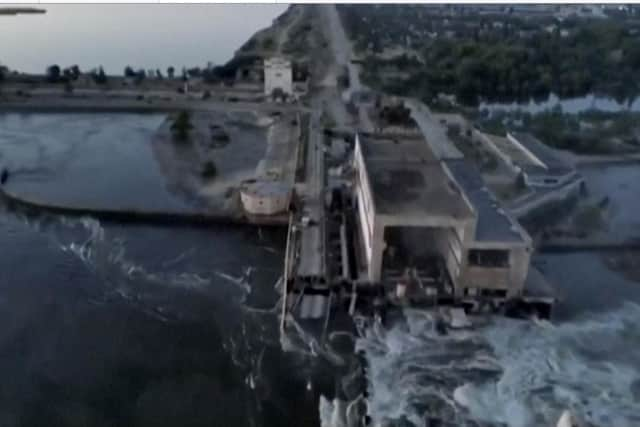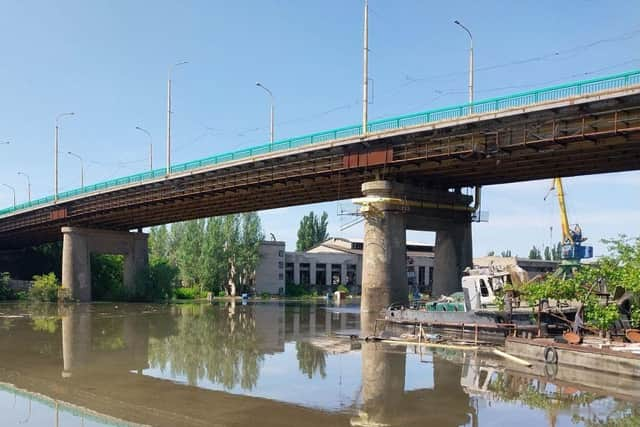War against Ukraine: Why the dam explosion is a ‘bomb of mass environmental destruction’
When a huge explosion rocketed the Khakovka dam and nearby hydroelectric power plant in eastern Ukraine in the early hours of Tuesday morning, it was not immediately clear what the consequences would be.
Some worried it could finally result in a long-feared nuclear disaster around Europe’s biggest nuclear power plant, in Zaporizhzhia, 100 miles from the blast – which could find itself cut off from water supplies usually used for cooling nuclear reactors.
Advertisement
Hide AdAdvertisement
Hide AdOthers warned of a widespread humanitarian and ecological disaster, with huge swathes of people living to the south of the dam in the Crimean peninsula annexed by Russia a decade ago left without drinking water. Hundreds of others would be left homeless as floods surged around communities on both the Ukrainian and Russian-controlled sides of the Dnipro river in the region.


Hours after the attack, local authorities said they still did not know what the full impact would be. However, international nuclear experts have said there is “no immediate risk” to nuclear safety, offering reassurances the Zaporizhzhia plant, which came close to being damaged in shelling attacks months ago, had other sources of cooling for its reactors.
Ukraine’s interior minister Ihor Klymenko said around 1,000 people – many of whom have already lived through Russian occupation and liberation – had been evacuated from the region and forced to find shelter elsewhere. A total of 24 settlements had been flooded by the dam waters. However, it is believed up to 15,000 more people are living in “critical” zones, which could still be affected by the spreading water.
He also issued a warning about the dangers posed by mines being exposed by the rising water levels and accused Russia of shelling citizens attempting to escape the flooded region.
Meanwhile, President Volodymyr Zelensky’s office said the Dnipro river has been contaminated with 150 tonnes of industrial lubricants as a result of the attack. Photos circulating on social media show villages entirely engulfed in brown water, with roofs just visible above the floods.


Messages are being exchanged on social media between Ukrainians offering help to those affected by the flooding.
"My friend is ready to evacuate people from flooded areas by boat – a boat with a motor,” said one tweet from a young Ukrainian soldier, with links to contact details.
What is not entirely clear yet is how the explosion occurred. Ukraine has insisted Russia carried out the attack, which cuts off a key route potentially set to be used by Ukrainian soldiers if Kyiv launched a counter offensive into Russian-held territory on the other side of the Dnipro river. Some Western authorities have expressed their support for Ukraine as a result of the incident.
Advertisement
Hide AdAdvertisement
Hide AdUkraine has said the scale of damage could not have been done purely by shelling and must have been a planned, co-ordinated blast. Mr Zelensky also pointed to the fact the region around the dam has been controlled by Russia for some time, making it "physically impossible" for Ukraine to have attacked it.


"Russia has been controlling the dam and the entire Kakhovka HPP for more than a year,” he said. “It is physically impossible to blow it up somehow from the outside, by shelling. It was mined by the Russian occupiers. And they blew it up.”
Mr Zelensky said the explosion had caused a “bomb of mass environmental destruction”, dubbing the situation “the largest man-made environmental disaster in Europe in decades”.
However, Russia has claimed Ukraine is behind the explosion and has launched a criminal investigation into the incident.
UK foreign secretary James Cleverly described the attack as a "catastrophe" and "abhorrent act". "Intentionally attacking exclusively civilian infrastructure is a war crime,” he said. “The UK stands ready to support Ukraine and those affected by this catastrophe."
Meanwhile, Charles Michel, the president of the European Council, also condemned the attack, saying he was “holding Russia accountable”.
He said: "[I am] shocked by the unprecedented attack of the Nova Kakhovka dam. The destruction of civilian infrastructure clearly qualifies as a war crime – and we will hold Russia and its proxies accountable.”
Evgeny Popov, a member of the Duma for Vladimir Putin's United Russia party, claimed Ukraine would "profit" from the damage and accused Ukraine of a "war crime" by carrying out the attack. He said around 22,000 people had been evacuated from the area by Russian authorities.
Advertisement
Hide AdAdvertisement
Hide Ad"We don't need to do that – we are not attacking civilian infrastructure,” he said.
A statement from the Russian Ministry of Defence claimed water releases from the Dnieper hydroelectric station had recently increased, leading to even greater flooding when the dam was breached. The body said this “proves” Ukraine had been preparing for the attack.
"The Kiev regime has carried out a sabotage, essentially a terrorist act,” it said.
Meanwhile, the pro-Russian head of occupied Crimea, Sergey Aksyonov, played down the effect on his region, saying the peninsula's water reservoirs were "about 80 per cent full”.
Volodymyr Kovalenko, the exiled Ukrainian mayor of the city of Nova Kakhovka, just a few miles from the dam, said he had been told the city’s zoo, theatre and residential streets had already been affected by flooding. Russian authorities confirmed on Tuesday afternoon that water levels had risen to more than 11m in the city.
Video footage showed swans swimming through the flooded streets, while unconfirmed reports claimed hundreds of animals in the city’s zoo had died in the flooding.
The explosion has caused a huge breach in the dam, which authorities have warned could be impossible to repair.
Ukrainian MP Kira Rudik urged international nuclear inspectors to visit the Zaporizhzhia nuclear plant to ensure its safety.
Advertisement
Hide AdAdvertisement
Hide AdThe UN's nuclear watchdog, the International Atomic Energy Agency (IAEA), said it saw "no immediate nuclear safety risk" at the plant. But the body warned a lack of water could disrupt its emergency diesel generators.
"IAEA experts at Zaporizhzhya Nuclear Power Plant are closely monitoring the situation; no immediate nuclear safety risk at plant,” the IAEA said in a tweet.
Patrick Regan, professor of Nuclear Metrology at the University of Surrey, described the incident as “clearly deeply concerning”. However, he said the nuclear risk was low.
"The risks regarding release of radioactive materials from the nuclear power plant at Zaporizhzhia appear to be limited at this time as the cooling of the fuel rods in their water pools seems to remain intact,” he said. “These are housed inside the reactor containment, but do rely on water from the nearby reservoir.
"The potential for loss of water in the cooling pools which could cause some fuel rods to melt does not seem to be an issue at present.”
Comments
Want to join the conversation? Please or to comment on this article.
